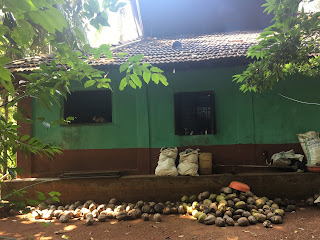The Roaring Orange!
The cool fresh air flows free, uninterrupted by rows of
tall cement structures. It lets the leaves, tiny and big rustle and dance in
the silence of the jungle. Lights around the house are few and distant with no
human out at this dark hour. Someone hears an unfitting sound in this tranquil
atmosphere, someone raises a quiet alarm.
Heartbeats duly respond to the sound of terrifying
silence. The pack of dogs unite and guard, although seconds away from instant
death. They growl and bark staring right at the black abyss of the bushes
preparing to fight the beast. It emerges with a stroke of lightning, its
glazing yellow-orange fur hard to miss, its eyes burning with fury.
The tiger’s expected entry is both majestic and
paralysing especially if you are its destined kill. Its roar enough to grip the
neck of its prey even before the teeth rip apart every muscle of its body. The battle
doesn’t last long, the housemates race to the juncture and so do the villagers,
but the tiger’s got what it came for. It resumes its run back to the dense
woods with the dead dog hanging between his sharp set of teeth. It’s injured too
by stones and sticks and has teeth marks in his skin, but at least tonight’s
catch will suffice till hunger possesses him again.
Life in this small village, Padoswadi near Kudal in the
Konkan belt has always been this way. Generations thrive and families grow.
Some leave for the city, while some continue staying in the village surviving
on farming and decent jobs offered by nearby cities. Children lend a helping
hand at home, on the fields and even attend regular schools. They are shy,
welcoming and very friendly. They love car rides and tell me so much more about
the trees than text books teach them. There are cats all over the house,
gliding like adventurers down the ceiling, curled up by the stove, playing
around, craving for fish. There is a neat, spaced out shed for the cattle. The
ones at my place have silver-painted horns and get as excited by food as a
hungry dog. The chickens have their own territory and flap their unfriendly
wings in anger. So I move to the places around the house I have not been to (in
several years) and notice that the affectionate pack of dogs has been noticing
me all this while, hoping I would pet them. So here I go.
The dogs are cute and don’t leave my sight. It is
unbelievable that this little army full of soft cuddles has to protect the
house and other pets from the beast. No wonder they do a fantastic job.
It dawns on me that things are just the same. I ask
questions I have been asking for years and get the same elaborate reply. What
is the deal with the tigers? Who is to blame?
Here is a miraculous word: Co-exist.
Villagers and tigers in this area have both been living
for years together. Tigers do not attack villagers unless harmed. Likewise,
villagers do not meddle with the spaces where tigers are believed to exist in
large numbers. Deforestation has played a villainous role though, disturbing
their habitat due to which many wild animals starve to death apart from losing
their homes. Tigers in this region are short, a peculiar breed but also meek.
Left with no choice, they are forced to attack domestic animals to at least
stay alive.
In spite of this, families do not abandon the village nor
do they hate wild animals, they simply accept and co-exist.
There is peace in the woods, in the farms and the red-soiled
pathways that take us places. There are brightly coloured homes and even
brightly-lit hearts showcasing faith and respect for everyone on the soil.




Comments
Post a Comment